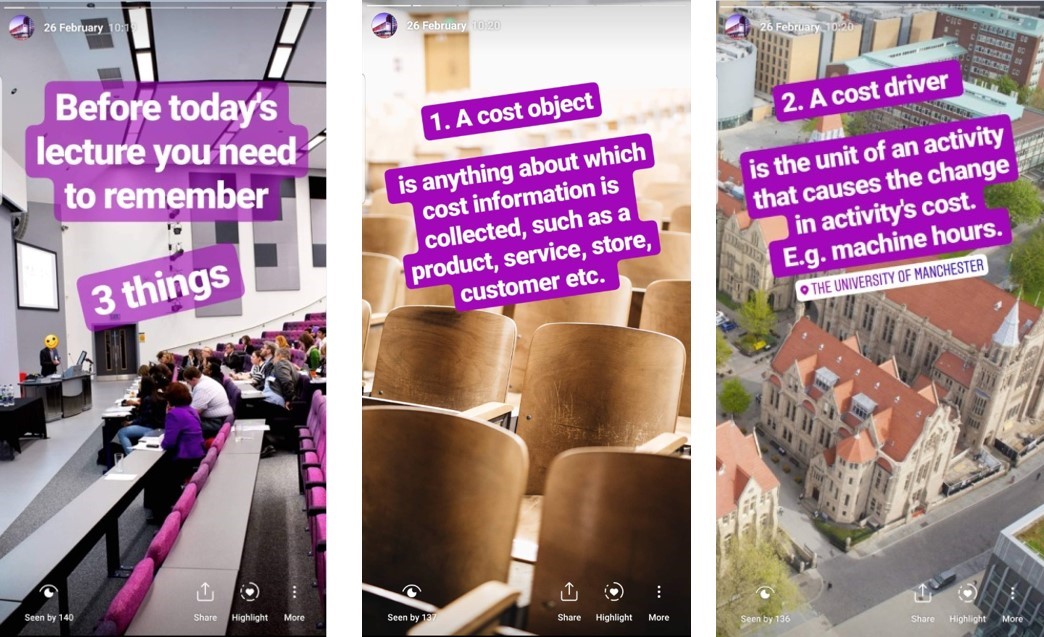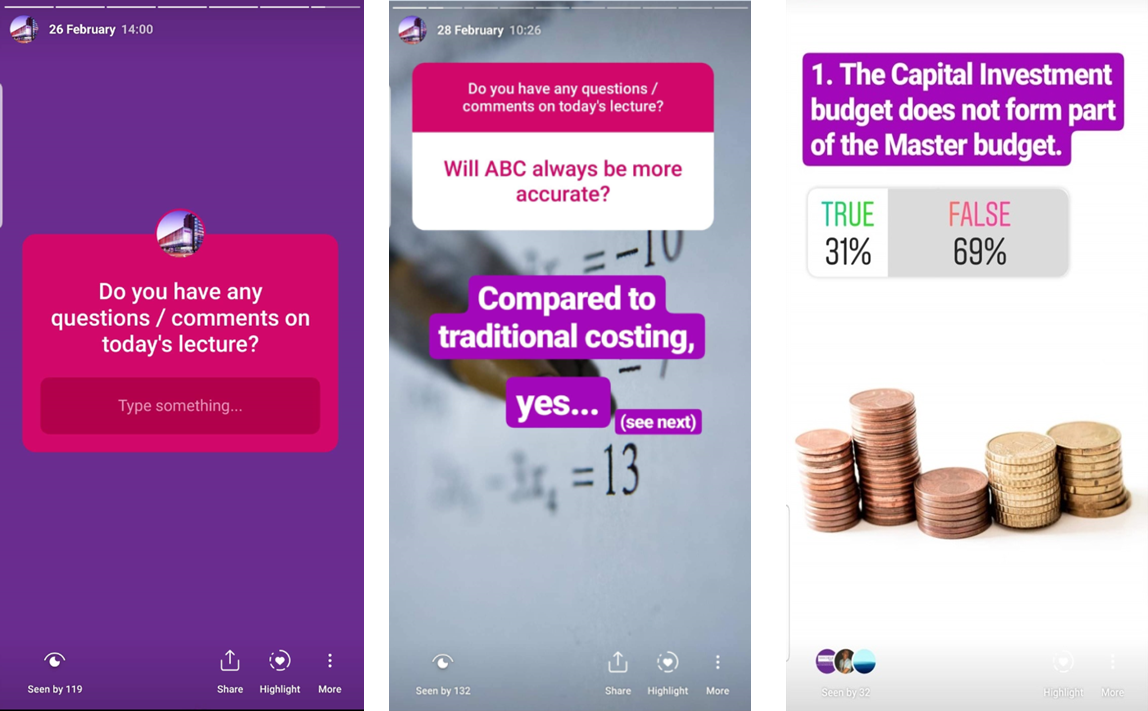Social media as a pedagogic tool
Shortly before the Covid-19 pandemic, Christos was responsible for lecturing over 440 undergraduate students on Introductory Management Accounting. Following students’ introduction to a specific topic in the form of a theoretical lecture five days in advance, Christos delivered demonstration lectures that provided students with step-by-step analyses of how they should go about solving difficult management accounting exercises related to that week’s theme. While it was clear that students were engaged during the face-to-face sessions, Christos was eager to build engagement with the content before and after the lectures. Christos decided that he wanted to explore a more flexible mode of delivery, which prompted him to consider the potential pedagogical uses of social media:
“I developed an Instagram account to complement my teaching of the demonstration lectures, accommodate flexible learning and digitally deliver content. I delivered content via stories* and regular posts, including key definitions, lecture highlights and general information”.
Staggered release of information
- In the days leading up to the lecture, students following the account could view posts highlighting theory and other useful information, such as venue details and countdown timers indicating when students could expect to access lecture material. This helped manage student expectations whilst building awareness of the upcoming lecture’s intended learning outcomes.
- In the hours immediately preceding the lecture, Instagram stories recapped the key theory that would support understanding of Christos’ analyses.

- Following the demonstration lecture, the use of Instagram’s ‘story question’ sticker offered students an opportunity to ask follow up questions, and thus also provided immediate feedback on the teaching.
- Once the story expired (approximately 24 hours after originally posted), Christos would anonymously repost the students’ questions to his stories alongside his responses. This enabled all students to benefit from the answers and allowed academic conversations to continue beyond the physical lecture theatre. Using Instagram’s polling feature, Christos accompanied his answers with quiz questions to allow students to check their own learning. As students responded they would instantly view their cohort’s average responses.

This relaxed and informal method of formative assessment encouraged student participation and allowed Christos to understand the proportion of students who had understood his lecture content.
Uptake and engagement
The Instagram account received instant student engagement: a few hours after notifying students of the account’s existence via email, it had received over 100 follows. By the end of week 10 this had risen to 260. On average, the account received 6,000 impressions (i.e., the number of times all stories from that week were seen) per week and students found the Instagram account to be having a positive impact on their learning.
As Christos explains:
“At the end of the semester I distributed a short questionnaire which demonstrated that more than 80% of students [following the account] found the material useful, it supported their learning, allowed them to engage with the material before and after the lecture, made learning more fun and increased interactivity with the course. Students said that the Instagram account was useful to break the distance [between lecturer and student], it’s innovative [and] students are able to learn very unexpectedly”.
Policy considerations and future use
Christos was aware of a few challenges that the use of Instagram in teaching posed. Due to the innovative nature of using social media for pedagogical purposes, there was no University policy which governed its use. This meant that there were several grey areas, for example whether the Instagram feed can be public or private or whether a course code could be used as an account name. Christos highlights further potential benefits and challenges of using social media for pedagogical purposes.
- In the instance that such social media course accounts are allowed to be public, this makes them a useful marketing tool at University open days by allowing prospective students to get a glimpse of the course as it was being taught throughout the Semester.
- Other issues are related to the ethics of having a University-owned Instagram account – for example, the account holder should never follow back any students or view their stories – and potential copyright issues when using other peoples’ images.
- To avoid copyright problems, where Christos didn’t use his own photography, he sourced content from University webpages and copyright-free photo-sharing websites.
Summary
Overall, the use of an Instagram account allowed Christos to accommodate flexible learning and deliver it through a digital medium that was fun and interactive. It also supported participatory learning by providing students with the means to post questions and offered regular opportunities for students to provide feedback in a more direct manner. Furthermore, quizzes allowed students to receive real-time formative feedback without the stress of a formal assessment – a benefit which students acknowledged.
Going forward, Christos’ students see real value in potential future uses of Instagram for teaching. One student commented that having course content on their phones and social media feed made it much more engaging and easier to access, whilst another believed that the use of social media “shows a motivation to connect with students in a more accessible and fun way”. This positive feedback has led Christos to disseminate his practice widely throughout Alliance Manchester Business School and the School of Arts Languages and Cultures.
*an Instagram story collates several images and/or short videos into a slideshow format that disappears after 24 hours. Unlike regular Instagram posts, there are no likes or public comments

 Dr Christos
Dr Christos 





0 Comments